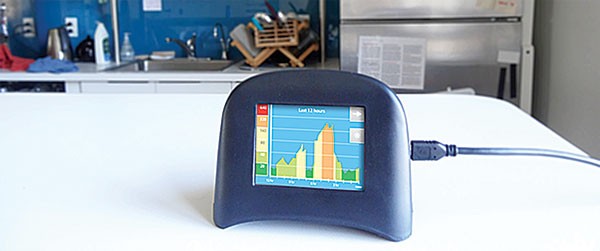For the past five months, the 10 small indoor air-quality monitors at the Carnegie Library's Squirrel Hill branch have been harder to check out then a New York Times best-seller.
"Ever since we put them out there, they have gone out consistently," says Jody Bell, library-services manager at the Squirrel Hill branch. "And we have not really marketed them at all except for a little sign at our circulation desk."
The monitors come from Carnegie Mellon University's CREATE Lab, whose mission is to empower the community with technology.
"We really care about this idea of technology fluency," says Bea Dias, CREATE Lab community-outreach coordinator. "That means understanding how things work and being curious about it."
For $200, you can also buy the small air monitor on the website of the lab's spin-off company, Speck.
However, the lab and Speck have also received funding from the Heinz Endowments and the Pittsburgh Foundation to distribute 1,000 monitors to community entities, including the Carnegie libraries. The library says that next they'll be available at the Hazelwood branch, and at other branches depending on their inventory.
"Our goal with putting them in the library is to help start this conversation both about how you can make better decisions and be informed about your home environmental health, and then to start understanding how you can use data to learn how decisions are made in the community," says Toby Greenwalt, the library's director of digital strategy and technology integration.
The Speck air monitor can measure the air quality in a person's home — fine particles that are released into a home's air via cooking, cleaning or possibly opening the window as a truck goes by. These fine particles measure 2.5 micrometers or smaller; that can be 30 times finer than a human hair. Those small particles can penetrate deep into a person's lungs, and the U.S. Environmental Protection Agency says several scientific studies have linked fine particulate matter to heart and respiratory-health issues, including premature death.
When patrons check the device out, they also receive a list of experiments to try at home, like "how does cooking something on your stove generate the amount of particulate matter in your home," Greenwalt says.
The monitor won't distinguish between sources, so patrons who use them at home might have to do a bit of "sleuthing" to figure out the reading, says Michael Taylor, a Ph.D. student at CREATE Lab who worked on the Speck project.
"For example, if the Speck is in a bathroom while a hot shower is running, it's probably just seeing steam, whereas a high reading in the kitchen during cooking might indicate smoke," Taylor says.
Other indoor sources of particulate matter include dust in the ductwork of forced-air heating and air-conditioning, as well as fireplaces. Outdoor sources can include diesel-fueled vehicles, like trucks, buses and trains; general car traffic; power plants and factories; and nearby fires.
But if a person sees high readings from, for example, frying onions for curry, as Dias says she noticed in her home, what can he or she do about it?
"We really want to empower them to become investigators in their home," Dias says.
Some ways to reduce harmful particles inside the home include using an indoor air filter (called a HEPA purifier); using cooking oil that has a high smoke point; using a quality vacuum cleaner; and regularly changing filters in exhaust fans and forced-air heating and cooling systems.
"That was a reason we targeted indoor air quality," Dias says. "As opposed to outdoor air quality, which is complex and difficult to change [in the short term], indoors you can really ... do a lot to improve the quality of the air you breathe."


